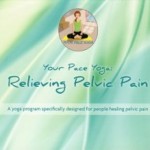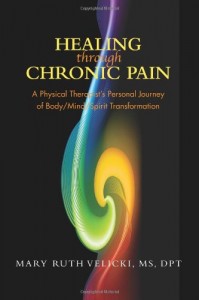A Physical therapist shares her favorite self-help strategies for patients with bladder or pelvic pain
(Editors Note: When physical therapist Mary Ruth Velicki was diagnosed with IC, she endured the same pelvic pain, frustration and anger that most IC patients struggle with. In this new article, she shares some of her favorite tips that helped her through the worst of it. From using relaxation to reduce painful muscle tension to writing in a journal to help reduce the undeniable emotional stress that pain creates, her tips can only help those struggling to find physical, mental and emotional relief. – Jill O.)
 (By Mary Ruth Velicki DPT, MSPT) Six years ago, I was working as a physical therapist and university instructor when IC/BPS pulled me out of my regular life. My main symptoms were bladder pain and inflammation, pelvic floor dysfunction and a nervous system that seemed to be set in over drive. Even though I had worked with people in pain for years as a therapist, I never really appreciated how difficult it was to live with chronic pain until I was there myself. It was a long journey, but my condition has improved dramatically, and the healing extended beyond my body to my whole person, transforming my internal and external life in positive ways. What follows are some of the ways that I coped during the roughest times and that continue to enhance my life today.
(By Mary Ruth Velicki DPT, MSPT) Six years ago, I was working as a physical therapist and university instructor when IC/BPS pulled me out of my regular life. My main symptoms were bladder pain and inflammation, pelvic floor dysfunction and a nervous system that seemed to be set in over drive. Even though I had worked with people in pain for years as a therapist, I never really appreciated how difficult it was to live with chronic pain until I was there myself. It was a long journey, but my condition has improved dramatically, and the healing extended beyond my body to my whole person, transforming my internal and external life in positive ways. What follows are some of the ways that I coped during the roughest times and that continue to enhance my life today.
Remembering to Breathe
 Breathing with the diaphragm is a natural way the body calms the nervoussystem and relaxes the pelvic floor muscles. The diaphragm is a large dome-shaped muscle, which attaches to the lower ribs and spine and separates the chest from the abdominal cavity. When the diaphragm contracts, it flattens and moves downward which squishes the abdominal contents and moves them outward. Placing your hands on your upper belly and feeling them move outward can cue you into this type of breathing. My yoga instructor once said, “Let your body breathe you” and when I focused on my automatic breathing and the movement of my belly, it calmed both my body and my mind.
Breathing with the diaphragm is a natural way the body calms the nervoussystem and relaxes the pelvic floor muscles. The diaphragm is a large dome-shaped muscle, which attaches to the lower ribs and spine and separates the chest from the abdominal cavity. When the diaphragm contracts, it flattens and moves downward which squishes the abdominal contents and moves them outward. Placing your hands on your upper belly and feeling them move outward can cue you into this type of breathing. My yoga instructor once said, “Let your body breathe you” and when I focused on my automatic breathing and the movement of my belly, it calmed both my body and my mind.
Focusing on the Body
When I consciously turned my focus to the sensations of my body, my mind settled in the moment and I felt more peaceful. Sometimes my pain levels would drop. The two activities that were most useful in this regard were progressive relaxation and yoga. With progressive relaxation, I would focus on a body part, feel the tension, consciously try to let go, and then accept whatever tension remains. By accepting what still remained I often relaxed even further. For me, the yoga classes that were most calming had a non-stressful flow of poses and a non-competitive, peaceful environment. Yin yoga, which uses long held postures to stretch the hips and pelvic area was also helpful. When I closed my eyes and focused on my breath and body sense, yoga became a moving meditation.
Two new resources are available if you would like help/guidance for these activities:
• Guided Meditations for Mindful Living – Mindful Body Scan by Alexandra T. Milspaw M.Ed, LPC
• Your Pace Yoga by Dustienne Miller PT, MS, WCS
Releasing Emotion
Four months into my pain, I was sitting in church, and the congregation began saying a prayer for people in pain and the tears began flowing down my cheeks. Try as I might, I just couldn’t make them stop. A few minutes later when the congregation began to sing my deceased mother’s favorite song, “On Eagle’s Wings,” I rushed out of the chapel and into the bathroom, locked myself in a stall, leaned my head against the wall, and sobbed.
This was my first experience of an emotional release, and I would understand later why this situation triggered the response. Over the years, I would have many situations that triggered an emotional release like this one, and they often gave me clues about a mental, emotional, or spiritual issue that was coming to the surface to be healed.
At the beginning of my illness, I rarely expressed emotion, so to have it burst out without my control was embarrassing, and I wondered about my mental health. But over time, I realized that holding my emotions inside was the unhealthy approach. I realized that I wasn’t weak; in fact, I had tried to stay strong for too long. Now, after years of healing, emotions flow through me with greater ease. If you are like me and hold yourself with steely resolve, consider that feeling can be healing.
Releasing Thoughts – Journaling
 Before my illness, I only wrote for my professional duties, and never for personal reasons. But when my pain rose up, it seemed like everyone was encouraging me to write, from friends to caregivers to strangers. So I began to write.
Before my illness, I only wrote for my professional duties, and never for personal reasons. But when my pain rose up, it seemed like everyone was encouraging me to write, from friends to caregivers to strangers. So I began to write.
I found that letting the journal page carry my thoughts really helped to lighten my overall burden. Once my issues and fears had a chance to settle outside of my spinning mind, they were often clearer and easier to deal with. Writing allowed me to appreciate where I’ve been and to see the growth that accompanied the pain. When I was feeling discouraged, it was helpful to have some measure that I was actually moving forward in the chaos.
Getting Help – Psychotherapy
Going to therapy was easier for me to accept because I initiated it myself and my initial focus was on helping my family cope with the illness. When I began counseling, I had no idea the support and guidance I received would be so helpful and crucial to my recovery.
During my counseling sessions, my psychologist gave me strategies to help stave off depression and adjust to the changes in my life and the loss that surrounded the illness. When other people in my life were afraid, overwhelmed, or simply not interested enough to talk, my psychologist was there.
In therapy, I uncovered the constricting, fear-based patterns, thoughts, and emotions that I carried, and once I recognized them, I had the option of choosing healthier options. This process was helpful for my whole person, because when my mind was calmer, so was my nervous system, and this calmer state decreased my pain and contributed to my healing.
About The Author
 Mary Ruth Velicki, a physical therapist and university instructor, endured intense, debilitating pelvic pain for years. In her new book, Healing Through Chronic Pain, Mary Ruth shares the treatment strategies she used and the support she received from a team of professionals to move past the pain and to heal. Unlike other medical care providers with IC, we’re thrilled that she is sharing her story publicly and providing such valuable help and assistance. If you feel that you’ve been struggling to find relief and peace, this book may help!
Mary Ruth Velicki, a physical therapist and university instructor, endured intense, debilitating pelvic pain for years. In her new book, Healing Through Chronic Pain, Mary Ruth shares the treatment strategies she used and the support she received from a team of professionals to move past the pain and to heal. Unlike other medical care providers with IC, we’re thrilled that she is sharing her story publicly and providing such valuable help and assistance. If you feel that you’ve been struggling to find relief and peace, this book may help!
Mary Ruth Velicki’s full healing journey can be found in the memoir, Healing Through Chronic Pain: A Physical Therapist’s Personal Journey of Body, Mind, Spirit Transformation on Amazon.com.
Learn more about Mary Ruth and her work on her website at: www.healingthroughchronicpain.com
